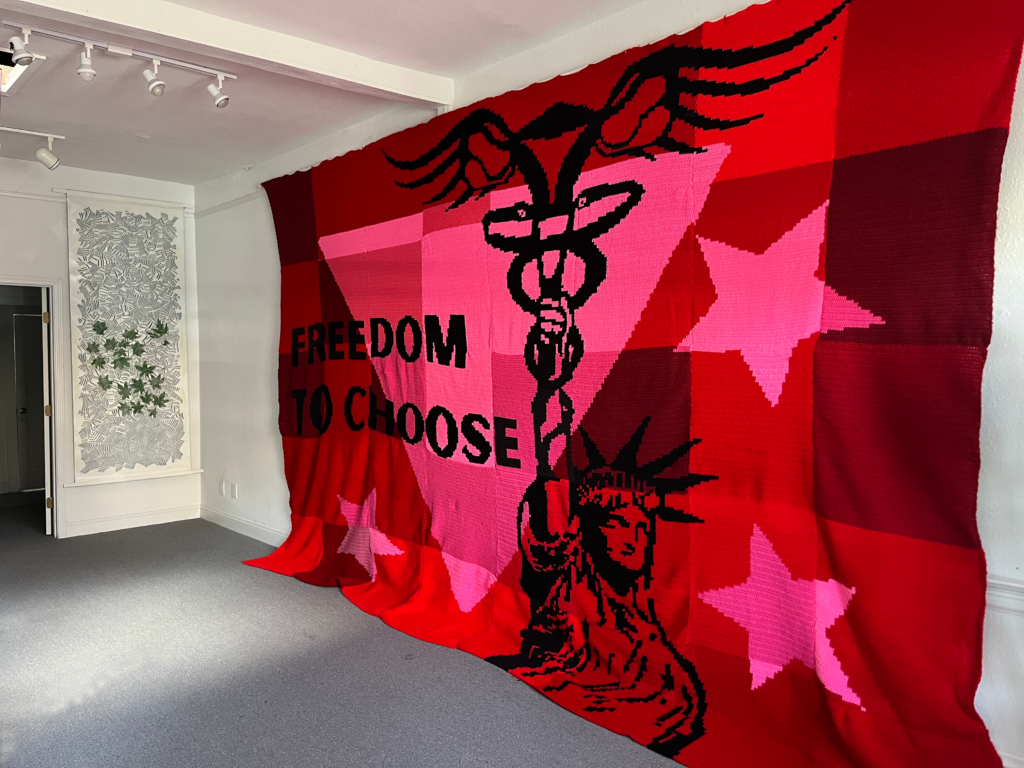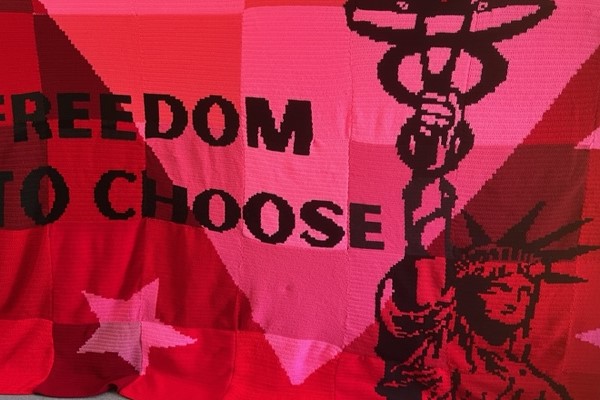During the Earth Day Stroll, I visited the Four Chicken art gallery located at 432 Cortland. I enjoyed admiring Marie K. Lee’s artwork and discovering the fascinating Liberty Crochet Mural.

Liberty Crochet Mural (LCM)
How did the Liberty Crochet Mural (LCM) come about?
When the United States Supreme Court overturned Roe v. Wade in June 2022, outraged fiber artist Jen LaMastra took inspiration from London Kaye’s community crochet work and designed the Liberty Crochet Mural. She called crafters across the country to help crochet the 40 squares; each is nearly 24” x 24” for 150,000 stitches, making the final mural approximately 17 feet wide by 11 feet tall.
Shortly after it was completed and displayed in her home state of Oregon, Jen decided it wasn’t enough. She put out a call for other craftivists to help organize additional LCM in other states. Her vision is to have an LCM in every state until the overturning is reversed. Jen has talked to around 25 states about creating their mural. As of May 2023, 12 completed murals are available to display in their respective states, nine are being created, and a few other states have organizers lined up but haven’t launched their call to action yet.
How did you learn about LCM, and how did you initially gather support and interest from craftivists nationwide to contribute to the Northern CA version LCM project?
In October 2022, I saw an Instagram (IG) post from local artist Twinkie Chan about how she had crocheted a square for the LCM in Kentucky. I then started following the @liberty_crochet_mural IG account. A few months later, I saw that there wasn’t an LCM in California. I was surprised there wasn’t one in here, but I also realized I was still angry about the overturning. So, I signed up to organize the Northern CA version. I did a call for crocheters on IG and thought that it was going to take me at least a week to get 40 volunteers on board to help. I envisioned myself stalking people at my LYS (local yarn store). To my surprise, I got more than 40 people signed up within 15 hours of putting out the request. After I got all of the squares from crocheters across the country, I then put out another call to have local stitchers help me assemble them. I got another dozen or so crafters to help with that part. There were even a few that didn’t know how to crochet but wanted to help out and were able to do hand sewing. It’s been awe-inspiring to see how many people are fired up about this topic and are willing to put in the time to help get this message out.
What message do you hope the Liberty Crochet Mural conveys to those who see it displayed in various locations?
I want it to remind us that we must fight for our health and safety. We must be bold on this issue. It’s not just our sexual and reproductive rights that are at risk; our right to health is being jeopardized – and not just those with uterus but also transgender and nonbinary people, people of color, marginalized communities, those in low-income areas, and healthcare providers.
I want it to be an eye-opener that June 24, 2023, marks one year since the overturning of Roe V. Wade, and it is nowhere near being reversed.
I also want it to inspire hope as well. We are not alone in this fight. We are starting to see that even conservative states (such as South Carolina and Nebraska) are standing up to the GOP.
Can you walk us through the symbolism in the LCM, such as the American Medical Association symbol and the pink triangle?
The LCM shows Lady Liberty elevating a uterus that is being supported by the American Medical Association symbol. The three stars recognize the Supreme Court justices who dissented: Stephen Breyer, Elena Kagan, and Sonia Sotomayor. The pink triangle symbolizes all people with uteruses and the full spectrum of reproductive healthcare needs.
What challenges have you faced in organizing the one LCM? And what challenges has Jen LaMastra faced in organizing multiple Liberty Crochet Murals in different states?
Jen and I agree that crocheting and assembling the mural was the easiest part. However, the hardest part is when the high of completing this great project with fellow craftivists wears off, and then you need to find someone/somewhere that will display the work. Currently, the Northern CA LCM is just sitting folded up in my guest bedroom – and I don’t have another venue lined up to display it.
Many challenges include the sheer logistics of displaying a piece this big. Then there’s just the straight-up politics of this message; and, consequently, the fear of vandalism to the venue/building that it is displayed. I live a few blocks from where Planned Parenthood used to be at the corner of Mission and Valencia. My partner Rob and I would always be surprised (and pissed off) that there seemed to be protesters outside that building every time we walked past it.
We aren’t so worried about the vandalism to the mural since it’s almost expected. When and if it happens (again) to any versions of the mural, we will document the mending we do to heal the wound, so it will become part of the story that we are telling.
Where has the Northern CA version of the mural been displayed? Are there any memorable reactions or stories from where the murals have been exhibited?
I was lucky to connect with the SF School of Needlework and Design (SFSNAD), who donated their space to let us stitch up the mural. Their new space is beautiful and felt the perfect place to gather and assemble this piece. >We could finish and premiere it on International Women’s Day (March 8). We hung it outside of the SFSNAD building for that one day. It was traffic-stopping! So many people (both on foot and in cars) stopped to take photos of it. SFSNAD then hung it inside their community room for several of their community room for a couple of weeks. Finally, we hung it in the Four Chicken temporary art gallery at 432 Cortland for the weekend of Earth Day. I met many of my neighbors and talked to them about this project. I moved to Bernal in 2019, and the pandemic happened, so I’ve not had much chance to meet other Bernalites before.
What are your plans for the Northern CA version of the Liberty Crochet Mural project, and how can people get involved or support the cause?
Unfortunately, it was supposed to be displayed in the Drawing Room on Valencia Street for a few weeks, but they recently lost their lease. We are desperately looking for venues to display it throughout Northern CA. I would love to have it prominently on display on June 24th to mark one year since the overturning of Roe V Wade. If anyone has any connections to display this piece anytime throughout the next year, hit me on @shes_crafty on Instagram. I created a hashtag on IG for those that want to keep up-to-date on it: #NorCALibertyCrochet. If anyone wants to get involved nationally, then follow @liberty_crochet_mural on Instagram. There are more than 25 states that do not have a completed LCM yet. You can also donate to the project at the Liberty Crochet Mural site. More importantly, don’t give up the fight. Find ways you can help on the ACLU site.
How has the community responded to the LCM project, and have you seen a surge in interest in craftivism since its inception?
It’s been amazing to witness people seeing the LCM for the first time. I’ve seen a few people get emotional and tear up. I’ve gotten thank you notes for putting this important message out there.
I’ve been into the concept of craftivism for quite a while. In 2009, when the Federal Communications Commission (FCC) mandated that all U.S.-based television signals be transmitted digitally, many televisions went into landfills. In response, I sewed a body bag for an analog TV and photographed it like a dead body at a crime scene. So, I don’t know if I can step back enough to see if there is a surge in interest in craftivism. But social media has made it more visible and accessible to people who aren’t just into arts and crafts.
What role do art and creativity play in social and political activism, and how has the LCM contributed to this perspective?
What role do art and creativity play in social and political activism, and how has the LCM contributed to this perspective?
There’s no denying that art has the power to move us emotionally. When the motive is to bring social change through art, and it’s successful, then there’s a deeper understanding as a society that things have to change.
Traditionally, crochet has been seen as “woman’s work” and, thus, an under-valued skill. The Liberty Crochet Mural is a subversive act challenging this tired narrative. The large-scale, bold colors and the declarative message are billboards amplifying millions of underrepresented voices. The LCM demonstrates the power of community, craft, and collaboration. It beautifully challenges the misogynist ideology of suppressing the right to bodily autonomy. With a crochet hook and yarn, we peacefully demonstrate our dissent. It’s meant to surprise and empower folks to engage in activism.

